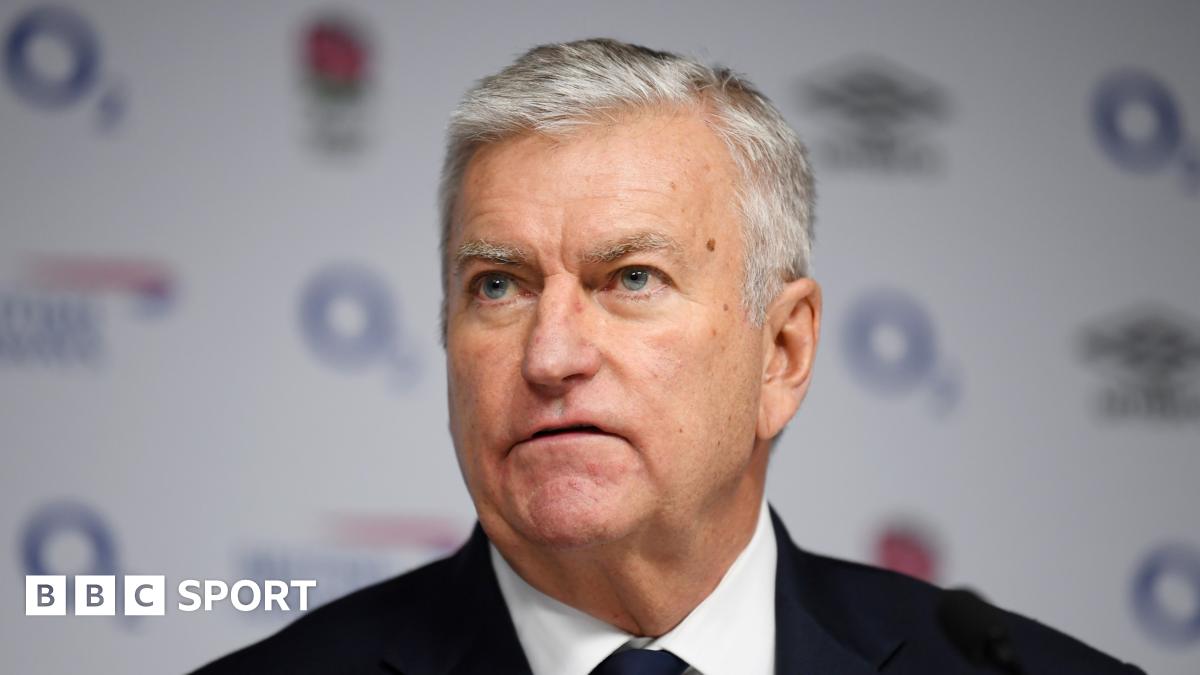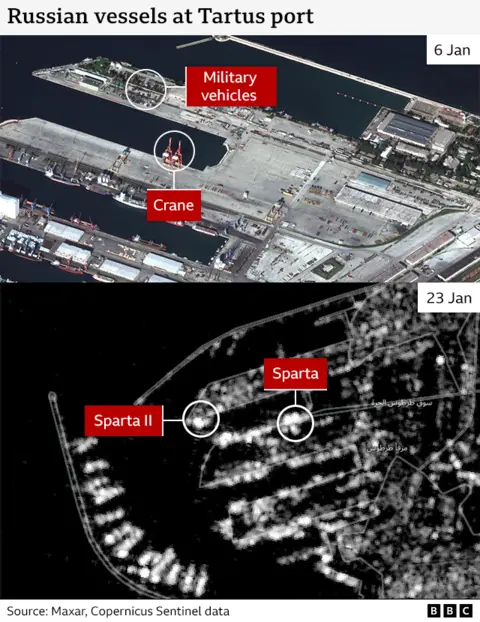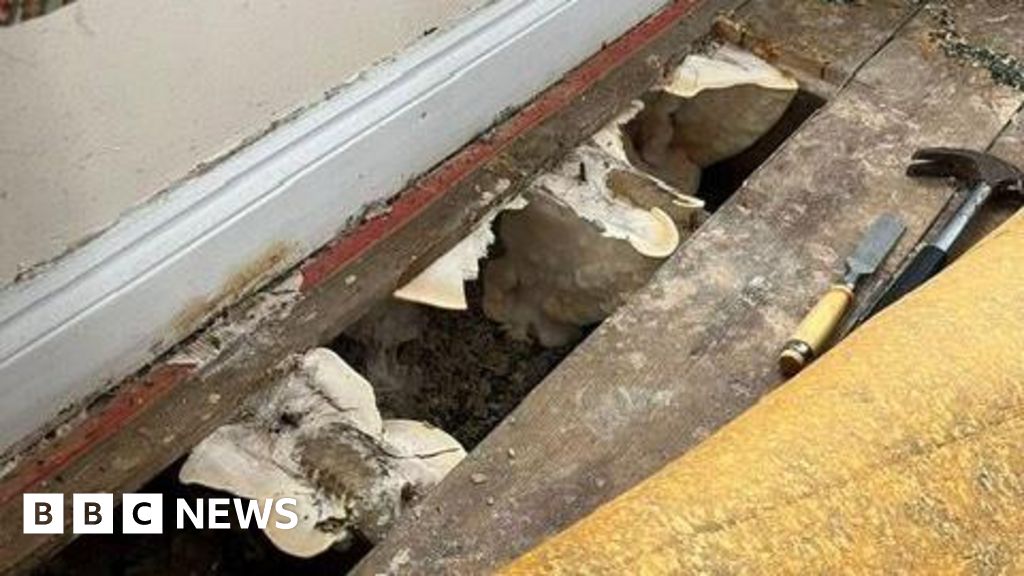NewsBeat
Bill Sweeney: RFU chief never considered resignation

Sweeney also denied speculation that he was planning to ride out the furore in the hope of stepping down in the wake of a successful Women’s Rugby World Cup later this year.
The tournament is being hosted in England, has already brought in record ticket sales, and the Red Roses are hot favourites to win the World Cup for the first time since 2014.
“I saw something a while back saying I have some specific bonus linked to a women’s World Cup win – that is not the case, that is not true,” Sweeney said.
“If I was in a mind to step down, I would have done it now and I wouldn’t wait until after a women’s World Cup.
“I still have some unfinished business here until the end of 2027. [England men’s head coach] Steve Borthwick is a great coach and we have a great squad of men’s players as well as women’s.
“There is a buzz and a good atmosphere around the place and I would like to see that through.”
Sweeney has said that, contrary to criticisms of his time in charge, he is proud of the RFU’s finances in the wake of the Covid pandemic.
The chief executive said record losses in the past financial year were down to the four-year cycle around the men’s Rugby World Cup, in which tournament years add extra expenses while wiping money-spinning autumn internationals off the fixture list, and a steep rise in utility and business costs.
He also defended his own pay, which was made up of £742,000 and a bonus of £358,000 last year.
Sweeney said that, while he had unsuccessfully explored the possibility of deferring his bonus payment, it was the result of a scheme intended to retain senior leaders through the pandemic and benchmark their performance against specific goals.
“When you are the recipient of something like an LTIP [long-term incentive plan], you don’t request it, you don’t design it, you don’t set the criteria for its payment,” he said.
“The payment was against very clear criteria of which 77% were hit, so part of me says that was put in place to deliver something to a level which we delivered.
“I don’t feel we need to apologise for that scheme.”
Sweeney and other RFU officials are embarking on a tour of grassroots clubs over the next few months to put forward their case before a special general meeting on his future.
Rob Sigley, the founder of the Community Clubs Union, believes it is already too late for Sweeney to win over many in the sport who feel that too much money has been focused on the elite game.
“We have openly called for his head and for him to resign,” said Sigley of Sweeney.
“He sits there at the top and is part of these decision-making processes and he’s accountable for it.”
NewsBeat
Stay at home warnings in Scotland and NI over risk-to-life winds

Millions of people have been urged to stay at home on Friday as Storm Éowyn is set to bring potentially life-threatening winds to the north and west of the UK.
Northern Ireland and parts of Scotland are set to experience the worst disruption, where the Met Office has issued red weather warnings which means there is a danger to life from winds gusting at up to 100mph.
Schools will be closed in Northern Ireland and much of central Scotland on Friday, while travel is also expected to be disrupted.
Away from the areas expected to be worst-hit by Storm Éowyn less severe amber and yellow warnings for both wind and rain have been issued, with 11 warnings in place for the UK on Friday and Saturday.
Red is the most serious weather warning the Met Office can issue, meaning dangerous weather is expected and people are urged to take action to keep themselves and others safe.
The red warning for the whole of Northern Ireland will be in force from 07:00 GMT to 14:00 on Friday, affecting the morning rush hour.
Bus and train services have been suspended in the country, while all schools have been advised to close.
In a message to customers, supermarket chain Tesco said all its shops in Northern Ireland would be closed on Friday – adding that home deliveries would be cancelled too.
The Irish Republic’s weather service Met Éireann has also issued severe red weather warnings amid the potential for “hurricane force winds” – with BBC Weather also warning it could be the storm of the century to hit the the country.
The storm is due to move east through Friday morning so a red warning is in place across Scotland’s central belt, including Glasgow and Edinburgh, from 10:00 to 17:00.
Schools in at least 20 local authorities – covering most of central Scotland – will be closed on Friday.
ScotRail has confirmed all rail services in Scotland will be suspended on Friday, adding that the closure was to ensure the safety of customers and staff.
Train operators Avanti, LNER, Lumo, CrossCountry, and Grand Central, TransPennine Express and Northern have also issued warnings not to travel in the north of England and north Wales on Friday.
The AA urged drivers travelling in red weather warning areas to consider whether a journey is necessary, and if not to postpone it.
Across the UK winds will rapidly increase from west to east on Friday morning into the afternoon with peak gusts of 80-90mph (129-145km/h).
There will likely be a large number of trees blown over with widespread disruption to travel with roads badly affected, and flights, trains and ferries will be subject to cancellations.
Power cuts are also likely, some of which could last for a number of days.
NewsBeat
New £9bn deal to build reactors for nuclear submarines will create 1,000 jobs, ministers say

Ministers have announced a new multi-billion pound deal for nuclear submarines they say will create 1,000 jobs and support 4,000 more, as Rachel Reeves scrambles to boost economic growth.
The agreement with Rolls-Royce to support the Royal Navy fleet, dubbed “Unity”, will also aid national security, the government said, days after the UK warned Russia ‘we see you’ as the Royal Navy tracked a Russian spy ship in the English Channel.
Defence secretary John Healey said the investment would “deliver a long-term boost” to British business and jobs.
The government suffered a blow on Thursday with an announcement by Sainsbury’s that it is cutting 3,000 jobs as it braces for a looming surge in costs, including higher taxes and wage bills, following Ms Reeves’s Budget.
Ms Reeves is facing a growing backlash to her plans, including to a hike in employers national insurance. She has also come under increasing pressure after recent figures showed a sluggish economy.

Last week the chancellor warned the rising cost of borrowing and falling value of the pound underlined the need for ministers to go “further and faster” in search of economic growth.
She is expected to use a speech next week to back a controversial third runway at Heathrow, despite deep division within her party over the environmental impact.
Asked about the airport decision while on the trip to the Swiss ski resort, she said that growth, as the government’s primary mission, trumped net zero considerations and was “obviously the most important thing”.
According to the government the new deal for submarines “streamlines previous contracts”, saving taxpayers more than £400 million over eight years.
Steve Carlier, the president of Rolls-Royce Submarines, said the long-term contract “enables us to invest in the right skills, equipment, and facilities to play our part in protecting UK interests at home and overseas.”
Mr Healy said the deal was also a “clear demonstration of our commitment to the UK’s nuclear deterrent, which is our ultimate insurance policy in a more dangerous world.”
The Ministry of Defence said the contract would deliver design, manufacture and support services to nuclear reactors to power the UK’s submarines.
Mr Healey will announce the agreement, worth approximately £9 billion, on a visit to the company’s nuclear production facility in Derby on Friday.
NewsBeat
Russian ships return to Syrian Tartous base ahead of expected withdrawal

BBC Verify
 PA Media
PA MediaTwo Russian ships linked to its military have docked at the Kremlin’s naval base on the Syrian coast at Tartous, with experts suggesting that an anticipated evacuation of the facility has finally begun.
The Sparta and the Sparta II docked in Tartous on Tuesday. Both ships are sanctioned by the US and have been linked by Ukraine to the transportation of Russian arms.
Analysts anticipated that Russia would reduce its military footprint from Syria following the fall of the Assad regime in December – which it supported throughout the civil war.
Large quantities of military hardware have been moved to the port in recent weeks and have been visible in satellite photos analysed by BBC Verify.
The imagery appears to show dozens of vehicles and other equipment sitting at the port. The hardware first appeared in mid-December following footage of large columns of Russian vehicles moving north towards the base – indicating they had been redirected from other outposts across the country.
 Maxar
MaxarThe ships arrival coincides with reports in Syrian media that Russia’s lease for the port has been cancelled. The new transitional government in Damascus refused to confirm the reports to the BBC, while Kremlin spokesperson Dmitry Peskov also declined to comment when asked during a news conference in Moscow.
Tartous has been a key base for Russia in recent years, allowing it to refuel, resupply and repair vessels in the Mediterranean.
The Kremlin has appeared keen to retain control over the base, and said in December that Russian officials were speaking to the new authorities about a continued presence.
Analysts have suggested that the Sparta and the Sparta II – which are ultimately owned by Oboronlogistika LLC – a shipping company which operates as part of the Russian ministry of defence, were denied permission to dock at Tartous while discussions continued. The ships have spent several weeks off the coast of Syria in the Mediterranean Sea.
Marine tracking sites show the ships finally docked on Tuesday evening, after which they switched off their transponders.
The weather in recent days has made it difficult to obtain clear satellite pictures. But images from the EU’s Sentinel radar satellites – which are low resolution but capable of penetrating cloud cover – revealed that the ships were in the military section of the port.

Until now, no Russian military vessels had been spotted at Tartous since the fall of Assad regime in early December. In earlier high-resolution satellite imagery dozens of military vehicles could be seen parked near where the vessels are now docked. Also nearby were cranes which may be used to load equipment.
It is possible that two other Russian naval vessels are also present in the port, naval analyst Frederik Van Lokeren told BBC Verify. He said the vessels, Ivan Gren and the Alexander Otrakovsky, could also be involved in an evacuation – a sentiment echoed by Ukrainian military intelligence to BBC Verify.
“With the 49 year lease being cancelled it has become very clear for Russia that it can no longer hope to maintain a military presence in Tartous and as such, there appears to be no point in staying there and delaying the maritime evacuation any longer,” Mr Van Lokeren added.
The evacuation of all of Russia’s equipment may take some though, according to Anton Mardasov from the Middle East Institute’s Syria programme.
“Over the years much more has been brought in there than these ships and vessels can take,” Mr Mardasov told BBC Verify.
Meanwhile, there has also been continued activity at the main Russian airbase in Syria, Hmeimim. Satellite images have shown large Russian aircraft being loaded with military equipment on various dates since the fall of the Assad regime.
 Maxar
MaxarUkrainian military intelligence said Russia flights had transferred military personnel and equipment from Hmeimim to airbases in Libya at least 10 times since mid-December. The Kremlin is already supporting the Tobruk-based warlord Khalifa Haftar in the east of Libya.
Moscow has long maintained a presence at two of the bases mentioned by Ukrainian intelligence – Al-Khadim and Al-Jufra. A former member of the UN’s working group on mercenaries, Dr Sorcha MacLeod, told BBC Verify that the facilities were previously run by the Wagner Group.
She said that Russia’s defence ministry has taken over responsibility for the bases through its new Africa Corps. The force is run directly by Moscow and has taken over much of the Wagner Group’s former role.
Dr Macleod added that the relocation of Russian forces to the country “makes sense given that Libya has become such a big hub for Africa Corps operations and access into West Africa”.
Additional reporting by Ned Davies and Joshua Cheetham. Graphics by Mesut Ersoz.

NewsBeat
‘You’re a coward’: Inside the courtroom where grieving families refused to be overcome by killer’s antics

Inside Liverpool Crown Court, a tense silence descended as victim’s families gathered in the public gallery, anxiously waiting for Southport killer Axel Rudakubana to enter the dock.
The sentencing hearing, scheduled for 11am, had already started late as police, legal teams, families and journalists had made their way through enhanced security amid heightened tensions over the shocking case.
Every seat was taken, with some choosing to sit in parts of the public gallery with no view of the dock. A piece of frosted glass obscured any chance of catching even a fleeting glimpse of the remorseless killer, described by his own lawyer as having a “total lack of empathy”.
Others, including the grief-stricken parents of Alice da Silva Aguiar, Alexandra and Sergio, had a clear view of the daughter’s murderer.

They watched as Rudakubana, tall and slight, finally entered the glass-screened dock wearing a grey prison-issue tracksuit and a surgical facemask like the one he wore on the day he targeted 26 defenceless girls at a Taylor Swift themed holiday class in Southport last July.
He refused to speak when asked to confirm his identity and sat slumped in the dock with his head bowed accompanied by five dock officers.
The sentencing hearing had come more rapidly than anyone had anticipated. They had all been braced for a harrowing four-week trial which they were spared after the 18-year-old changed his plea without warning on Monday. However, any hope the families had that Rudakubana would accept his punishment with dignity were soon dashed.
Within minutes of prosecutor Deanna Heer KC launching her address, Rudakubana – who had refused to speak entirely at several previous hearings – started to shout over her.
“I need to speak to a paramedic,” he shouted. “I need to speak to paramedic I feel ill.”
Reports published that morning, later contested by police, claimed he had been taken to hospital from prison before the hearing.
Rudakubana’s lawyer Stan Reiz KC revealed prison staff had raised concerns over his wellbeing and his ability “to be in a high-pressure situation”.
“He has not eaten for a number of days and he’s drunk very little over a period of time,” the lawyer said.

However judge Mr Justice Goose said he had been examined by healthcare professionals before the hearing, who determined he was fit to attend, and told him to stay quiet.
“I can’t remain quiet because I am ill judge,” he protested. “I haven’t eaten for ten days and I’m not going to remain quiet.”
Despite attempts to carry on, he continued to shout over Ms Heer and then told his lawyer he was experiencing chest pains.
The judge, determined to continue, warned him “shouting from the dock is not going to make this happen any quicker”, but the killer refused to stop interrupting. He was ordered from the dock.
A family member shouted “coward” as he was led to the cells by dock officers, while others shook their heads in disgust.
The evidence that followed as Ms Heer recounted the horrifying details of the brutal knife attack was harrowing. Families broke down in the public gallery, with many leaving the court before distressing CCTV footage of the screaming girls fleeing in terror from the knifeman was played.
One clip showed Rudakubana grabbing a girl as she tried to escape and pulling her back into the Hart Space. Moments later, the seven-year-old dressed in summer shorts emerged stumbling and disoriented with visible injuries.
She clung to a wall for a few seconds, looking for her route to safety, but collapsed on the floor. Miraculously, she survived her injuries.
After lunch Rudakubana returned to court, having been seen again by healthcare professionals. He had told his lawyer he would be quiet, but within minutes the interruptions resumed.
“Judge, judge I feel really ill,” he continued. “I need to be seen by a paramedic.”
The judge responded: “He has been seen by a paramedic – two teams of paramedics who deem he’s fit”, before he was ordered from the dock for a second time.

His absence meant he was not in court to listen to a string of devastating victim personal statements, some of which were delivered in person.
One brave survivor, aged just 14, who was stabbed in the back and arm delivered her own victim statement via videolink. She demanded “give me a reason for what you did” as she told her attacker: “I hope you spend your whole life knowing that we think you’re a coward.”
Jailing him life with a minimum of 52 years, Mr Justice Goose said it was highly unlikely Rudakubana would ever be released.
Some family members could be heard to take an audible breath as the sentence was announced. Outside court, they held hands and hugged.
Later, police lined the street as Rudakubana’s prison van was set to leave the court. The killer, who will likely serve his sentence in a maximum security jail, will not be eligible to apply for parole until 2077.
NewsBeat
‘Serious and systemic’ problems found in insulated homes, minister says

Serious and systemic problems have been found in homes insulated under government schemes, according to the Minister for Energy Consumers.
An audit of homes that have had external wall insulation since 2022 found ”widespread cases of poor-quality installations that did not meet the required standard”, Miatta Fahnbulleh told Parliament.
She added that 39 businesses have now been suspended from the government schemes as a result of poor-quality work.
Some 65,000 households in the UK have had solid wall insulation installed under two government schemes – ECO4 and the Great British Insulation Scheme – since 2022.
All homes that have had external wall insulation fitted under the schemes would be contacted by the energy regulator Ofgem, the minister said, with repair work overseen by the regulator and the cost met by installers.
The audit, which was carried out by the independent organisation Trustmark found problems ranging from missing or incomplete paperwork to more serious problems such as exposed insulation and poor ventilation which, if not fixed, could lead to damp and mould. In some cases, serious health and safety concerns were raised such as wires not being fitted properly.
Last year the BBC highlighted the case of Tormuja Khatun, whose Luton home has been consumed by black mould, mushrooms and dry rot after the botched installation of external wall insulation. Her family told the BBC they had been warned it could cost more than £100,000 to repair and described the situation as a “nightmare”.
In total more than three million homes have been insulated under government schemes and the BBC reported last year that hundreds of thousands of them could have insulation that wasn’t installed to the required standard.
A growing number of MPs are worried about the impact on their constituents of poorly installed insulation, while Citizens Advice has called on the government to “urgently fix” regulation of the sector.
In a statement to the House of Commons, Fahnbulleh said: ”The government is moving fast to protect households. But I have to be honest with the House – these issues are the result of years of failure in a system that must be reformed.
“I know that this will be concerning for families who have had solid wall insulation fitted through these schemes. Getting this sorted out is our number one priority. We are determined to make sure families are never let down in this way again.”
But some MPs voiced their concerns that the government did not announce a review of other insulation schemes, such as those involving cavity wall insulation and spray foam insulation.
Fahnbulleh said audits of other forms of insulation had not shown the “systemic failure” found with solid wall installations.
The minister’s statement was welcomed by the Energy Saving Trust (EST), which has been calling for a national expert advice service in England to provide all households with impartial, tailored advice.
“It’s equally important that steps are now taken to strengthen consumer protection and support going forward, to ensure households have confidence when upgrading their homes,” said Stew Horne, head of policy at the EST.
NewsBeat
‘Mini-tornado’ rips through Cornish resort town

A suspected mini tornado caused havoc when it swept through a Cornish resort town on Thursday.
Mobile phone footage showed chaotic scenes on a residential street in Quintrell Downs, near Newquay, as the high speed winds and torrential rain battered the area.
Rubbish and debris can be seen flying across the road and smashing into houses and vehicles. Caravans could be seen flipped over and completely destroyed at a nearby holiday park.
In Newquay, shocked residents also shared pictures of damaged roofs and walls.
It comes ahead of a Met Office yellow wind warning for the region on Friday morning as Storm Eowyn makes landfall.
Cheryl Foers, who lives in the area, told BBC News: “It was a freak, everything was twirling in the air, plant pots and so forth.”
“A light breeze started then a strong wind, then literally from nowhere a tornado ripped through. There were trees uprooted, it just came through in five or 10 seconds,” she added.
“It’s just left carnage, there’s at least at least seven or eight roofs that are almost missing, chimney pots affected, trees uprooted, it was very dangerous and then the tornado just went off across the fields.”
Trevornick Holiday Park said on Facebook there had been “some damage” in a “very isolated area of the park” and a clean-up operation was under way.
Video showed caravans flipped over with debris scattered across the park’s grounds in Holywell Bay. The strong winds hit between 9:30am and 9:45am GMT, according to weather maps.
A park spokesperson said: “We’re sure many of you have seen the news today that a mini-tornado swept through Newquay – yes really, we still can’t quite believe it either.”
Around 30 tornadoes a year are reported in the UK. These are typically small and very short-lived but can cause structural damage if they pass over built-up areas.
On Wednesday night, the European Storm Forecast Experiment issued an alert for tornados in the south of England across Thursday.
On Friday, a rare red weather warning is in place for Northern Ireland and parts of Scotland. The worst to the storm is expected to hit the south and east of Northern Ireland with gusts of up to 80mph.
Elsewhere, yellow and amber weather warnings are in place across the country.
“Injuries and danger to life could occur from flying debris, as well as large waves and beach material being thrown onto sea fronts, coastal roads and properties,” a Met Office spokesperson said.
For live updates on Storm Eowyn – visit our live blog by clicking here.
NewsBeat
Trump orders release of JFK, MLK assassination documents

US President Donald Trump has ordered the documents related to three of the most consequential assassinations in US history – the killings of John F Kennedy, Robert F Kennedy, and Martin Luther King Jr – to be declassified.
“A lot of people are waiting for this, for long, for, for decades,” Trump told reporters in the Oval Office on Thursday. “Everything will be revealed.”
President John F Kennedy was killed in 1963. His brother Robert F Kennedy was assassinated while running for president in 1968, just two months after King, America’s most famous civil rights leader, was murdered in Memphis, Tennessee.
Many of the documents related to the investigations have been released in the years since, although thousands still remain redacted, particularly related to JFK.
Trump asked for the pen he used to sign the order to be given to Robert F Kennedy Jr, who is RFK’s son, JFK’s nephew and the president’s nominee for health secretary.
John F Kennedy was killed in Dallas by Lee Harvey Oswald. But alternative conspiracy theories about the involvement of government agents, the mafia and all sorts of other nefarious characters have long dogged the case.
RFK Jr has long cast doubt on the official narratives about his uncle’s assassination as well as that of his father RFK.
Trump promised to declassify all of the JFK files in his first term, but held back on his promise after CIA and FBI officials persuaded him to keep some files secret. Today’s executive order states that continued secrecy “is not consistent with the public interest”.
A 1992 law required the classified files to be released within 25 years. Trump didn’t quite meet the deadline, and neither did former President Joe Biden when he released more documents in 2022. A few thousand – out of millions related to the assassination – have yet to be fully revealed.
In recent years there have been some new details that have come out of document releases, including about the CIA’s monitoring of Oswald.
NewsBeat
Southport: Axel Rudakubana’s family ‘devastated’ and living in secret location

The family of Axel Rudakubana are “devastated” following his knife attack on a Southport holiday club, the church attended by his father has said.
The 18-year-old, of Banks, Lancashire, killed six-year-old Bebe King, Elsie Dot Stancombe, seven, and Alice da Silva Aguiar, nine, and injured 10 others when he launched the attack at a Taylor Swift-themed dance class on July 29.
In a statement, leaders of The Community Church in Southport, attended by Rudakubana’s father Alphonse, said the family had been moved to a secret location for their protection.
Church leaders Dave Gregg, Geoff Grice, Harry Pickett and Mike Rothwell, said: “Axel was born and went to school in the United Kingdom, he has autism and has struggled with mental health issues.
“Prior to the major incident in Southport, he had been living with his parents in the village of Banks near Southport.
“There has been the inevitable speculation about his family and background – with his father Alphonse being named in the national press.
“It has also been reported that his parents are both Christians and attend a local church.
“To prevent unnecessary intrusion into other churches in our town, we can confirm that over the last few years Alphonse Rudakubana has been a valued part of The Community Church family.”
“For the sake of clarity, Alphonse’s son and family never attended our Sunday gatherings, nor played any active part in church life. As a consequence we have nothing further to say other than the detail given in this statement.
“The Rudakubana family have been devastated following this terrible incident and they have been moved by the police, for their protection, from their home in Banks to a secret location that we are unaware of.
“As a church we continue to pray for peace and healing for all those impacted by the tragic events that took place in Southport and in our nation beyond.”
Leaders said the church community had been “saddened and shocked” by the attack.
They added: “This tragedy and the devastating murder of Bebe King, Elsie Dot Stancombe, and Alice da Silva Aguiar has impacted our town and nation.
“The subsequent outpouring of love and support by the local community actually reflects the true nature and spirit of our town, but sadly, this was eclipsed by the appalling attack – fuelled by fake racially motivated news on social media – on the local mosque, which resulted in so many awful injuries to police and damage being caused to buildings and property.”
NewsBeat
America’s Cup: Ben Ainslie splits from Sir Jim Ratcliffe’s Ineos Britannia sailing team

Four-time Olympic champion Ben Ainslie has split from Sir Jim Ratcliffe’s Ineos Britannia America’s Cup sailing team.
Ainslie, 47, reportedly, external had a strained relationship with Manchester United co-owner Ratcliffe regarding plans for the next America’s Cup which prompted them to part ways.
Ainslie was Ineos Britannia’s team principal and skipper, having got the backing of Ratcliffe in 2018 in a bid to a deliver a first win for Great Britain in the yacht race since it started in 1851.
Ineos said in a statement that they could “not find agreement” with Ainslie on “terms to move forward” after last year’s event in Barcelona which was won by New Zealand.
Ineos plan to compete in the next America’s Cup under the Britannia name.
Ainslie’s team said in response they were “astounded” by Ineos’ future plans for the America’s Cup and it “raises significant legal and practical obstacles for them”.
Following the split, Ainslie’s America’s Cup team will be known as Athena Racing.
Ratcliffe did not address the split with Ainslie directly in the Ineos statement but said he was “enormously proud” of “developing a British boat that was truly competitive for the first time in decades”.
Ainslie won medals at five consecutive Olympics from 1996 onwards, including gold at four consecutive Games from 2000 to 2012.
Since winning gold at London 2012, Ainslie’s goal has been to claim the America’s Cup for Great Britain but all his attempts in a British boat, including those backed by Ineos, have ended in disappointment.
NewsBeat
ICC prosecutor calls for arrest of Taliban duo over ‘persecution’ of women | World News


The chief prosecutor of the International Criminal Court (ICC) has told Sky News he is seeking the arrest of two senior Taliban figures over the “systemic and deliberate” persecution of women in Afghanistan.
Karim Khan KC, speaking on Sky News’ The World with Yalda Hakim, said the pair bore “criminal responsibility” over the treatment of women and girls in the country.
It comes after the ICC announced earlier on Thursday it had filed two applications for warrants for the arrest of Taliban supreme leader Hibatullah Akhundzada and Afghanistan‘s chief justice Abdul Hakim Haqqani.
Mr Khan said: “The charges are gender persecution. It’s the systemic, we say, organised, deliberate, malicious suffocation of women, the targeting of girls and women, the denial of their rights to education, access to any public spaces, the inability to go to beauty salons, the inability to walk in the park, the inability really to have hope.
“And this isn’t something doctrinal. This has crossed every threshold and we say clearly is criminal. And that’s what we presented to the judges of the International Criminal Court to consider.”
The prosecutor said the evidence was “overwhelming” and that the charges amounted to the “crime against humanity of gender persecution”.
Human rights groups have heavily criticised Taliban leaders since they took back control of Afghanistan in 2021.
Under their leadership, women have faced a string of restrictions over their daily lives, including over work, education and freedom of movement.
Read more from Sky News:
Southport killer jailed
Red weather warning over Storm Eowyn
Sainsbury’s to cut 3,000 jobs
Mr Khan added: “This isn’t some acceptable choice from a menu of options that states can choose from. This isn’t about religious autonomy of doctrinal beliefs of Christianity or Islam or Buddhism or anything else for that matter.
“This has crossed every threshold in which women can either be seen or heard. Women can’t go to university. Girls don’t have an opportunity to go to school”.
There is no deadline for judges to rule on a request for a warrant, but a decision typically takes around four months.
-

 Fashion8 years ago
Fashion8 years agoThese ’90s fashion trends are making a comeback in 2025
-

 Entertainment8 years ago
Entertainment8 years agoThe Season 9 ‘ Game of Thrones’ is here.
-

 Fashion8 years ago
Fashion8 years ago9 spring/summer 2025 fashion trends to know for next season
-

 Entertainment8 years ago
Entertainment8 years agoThe old and New Edition cast comes together to perform You’re Not My Kind of Girl.
-

 Sports8 years ago
Sports8 years agoEthical Hacker: “I’ll Show You Why Google Has Just Shut Down Their Quantum Chip”
-
Business8 years ago
Uber and Lyft are finally available in all of New York State
-
Entertainment8 years ago
Disney’s live-action Aladdin finally finds its stars
-
Sports8 years ago
Steph Curry finally got the contract he deserves from the Warriors
-
Entertainment8 years ago
Mod turns ‘Counter-Strike’ into a ‘Tekken’ clone with fighting chickens
-
Fashion8 years ago
Your comprehensive guide to this fall’s biggest trends






You must be logged in to post a comment Login